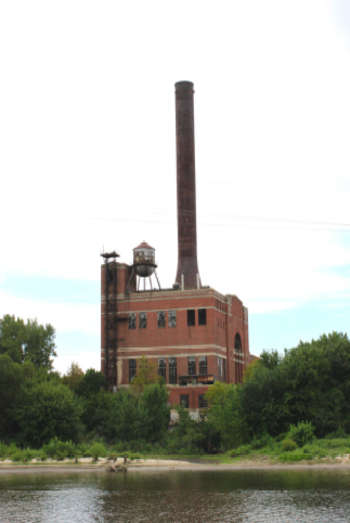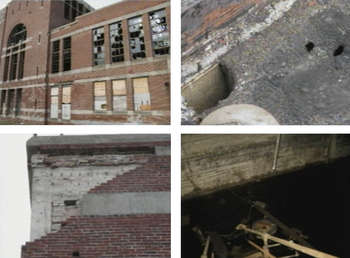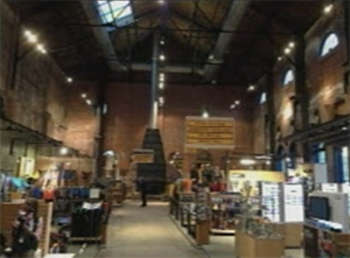FMR opposes local historic designation for St. Pauls Island Station

St. Pauls Island Station, as viewed from the river
Photo: City of St. Paul
A day of reckoning is at hand for Island Station, a nearly century-old presence along the river in St. Pauls West Seventh neighborhood, as the St Paul City Council is poised to vote on local historic designation for the large brick structure. As we will explain, after careful consideration of the realities facing the site, FMR opposes local historic designation for Island Station.
Last year, Burnsville-based Breckner Riverfront Development began pursuing demolition of the decommissioned coal power plant. Before a demolition permit was issued, the City put a year-long moratorium on the site, and St. Pauls Heritage Preservation Commission (HPC) undertook a study to review the potential options of the site.
The HPCs study clearly concluded the site was not eligible for protection on the National Register of Historic Places. That represented a substantial setback to any preservation at the site, because properties on the National Register are eligible for state and federal tax credits that are often essential in underwriting the substantial costs of historic preservation.
But in some cities, like St. Paul, there is a second tool available for protection local city-level historic designation. The criteria for local designation is somewhat different than federal designation, and the plan is eligible for designation under two criteria (though the criteria only make it eligible, not required, for designation). Perhaps the most notable of these is criteria seven, Its unique location or singular physical characteristic representing an established familiar visual feature of a neighborhood, community, or City of St. Paul. Citing this criteria, the St. Paul HPC recommended to the City Council that Island Station be designated.
But although local designation affords a level of protection to historic properties, what is particularly challenging about this project is that unlike designation on the National Register, local designation on its own does nothing to unlock any additional financial assistance for the preservation effort. And from all reports, this project needs resources. All the analysis available suggests a gaping hole between what it would cost to rehab the building, and what the market would be willing to pay for the project. Usually government programs provide the one and only source to fill such a sizable gap, and those seem likely hard to come by.
Owner struggles with economic realities of redevelopment
Breckner River Development helped to finance a redevelopment of the site in 2004 and 2005. But by 2006, at the height of the condo boom, those redevelopment plans fell apart, given the very substantial costs of rehabilitating the massive structure. Breckner inherited the building then and has been trying to market it ever since.

Island Station is showing increasing signs of deterioration, including (clockwise from top left) broken windows, holes in the roof, frequent flooding of the structure, and collapse of sections of the brick exterior. A frequent target for urban explorers, it generates more than its share of safety and security concerns.
Photo: Breckner Riverfront Development
Part of the challenge lies in the deteriorating state of the building. The windows are broken out, the walls are crumbling, the building floods routinely, and the roof has caved in in some places. St. Paul inspectors and emergency responders stay out of the building except to address true emergencies. And there are plenty of emergency calls to the site, including a fire in the building just weeks ago.
Any developer will want to maximize the amount of floor space to pay for the considerable stabilization and preservation work needed on the structure. But unlike many historic warehouses, this very tall structure has but one floor. To add floors, youd have to build a building inside of a building, says co-owner Paul Breckner. Thus, the cost to convert the building to condos in 2006 was projected to be $800 to $1,000 per square foot, according to Breckner; most Twin Cities homes sell for less than $200 per square foot.
Breckner describes the lengths to which he has gone to market the property, telling the City Council:
We had [property broker] Welsh bring it to over 50 developers both locally and national to try to sell the building and see if there were some other ideas that would come out of this thing. In the fall of 2007, the National Historic Trust was in St. Paul, and came here for their national meeting. We had a letter circulating, and I was there myself going booth to booth, showing them the package, asking for ideas [on] how we can redevelop this project. There was interest by everybody to preserve the building, to do something with it, looking for ideas. We really didnt get any.
I went to the Carlson School of Business [at the University of Minnesota] Ive tried, for years, to come up with an idea and, we just dont have any. Even the best and the brightest have not been able to come up with an idea for this project that makes any economic sense. We did also pursue other things: fish farming, big tanks; LG to diesel was an idea. We looked at datacenters.
Its clear that there is a major economic challenge in redeveloping the project. Yet a number of neighbors see the building as an essential part of the future of their neighborhood and the riverfronts rebirth.
Community values iconic connection to river and neighborhoods past
Local architect and resident John Yust told the City Council on July 12th he sees great potential in the structure. This represents a great opportunity to be up high over the river, said Yust, and see great sunsets over the river to the west, to see a great skyline of downtown St. Paul, develop a great marina on the river, this is an important centerpoint for the river.

A power plant in Denver along the Platte River with similarly soaring ceilings has been restored as an activity hub similar to that envisioned for the Island Station site.
Photo: John Yust
Yust looks to a power plant restoration in Denver on the Platte River as a guide. That power plant, is a huge building; its absolutely full of people. Its a just delight to be in that building. It has a climbing wall, and thats what weve been talking about in the Great River Passage Plan.
Kent Peterson told the Council he thinks theres a real synergy that can be developed between the brewery and along Randolph and all the things Island Station could be.
Longtime local resident Richard Miller finds hope in other area examples. The slides of the current state of the structure are dismal and despair-producing. But Im reminded of the condition of the Mill City Museum, victim of an explosion prior to its restoration and redevelopment, and it is now a very popular museum where there is a will, there is a way.
Great River Passage Plan: a new public riverfront hub
One way or another, historic preservation and economic realities will be reconciled at the site. And however that is achieved, there is one additional priority for the site that exists independent from the issue of historic preservation. City leaders clearly hope Island Station area becomes a very public and iconic gateway to the river environment.
The land at Island Station creates an ideal hub for small-scale recreational boaters, with an easy, shallow grade into the water. The separation between whats left of the erstwhile island and shore creates the ideal space for a new, small-scale marina. In recent years, the National Park Service has taken thousands of urban youth out on the river each year for a one-of-a-kind experience, and this would be an ideal launch site. While many would love the National Park Service to locate in their city, the Island Station site is one of the few that seem a real possibility to move their headquarters.

A range of uses is envisioned for the Island Station area.
Photo: City of St. Paul
Following this logic, St. Pauls Great River Passage Plan, adopted earlier this year, centers partly around the idea of creating a key outdoor activity hub on Island Station. Ice skating, zip lines, rock climbing, bike rental, a café, canoeing and kayaking are all contemplated in City plans for the site. Concepts for the area aspired to include the existing historic structure in a re-imagined public space; however, many would acknowledge that most of these kinds of uses could just as easily and perhaps more easily - exist without the building.
Opportunity costs, and planning for the future
If this project requires in the millions and quite possibly tens of millions of dollars of public financing to complete, it may be a very long time before Island Station is stabilized, much less renovated. At present, its a long way from clear from where such funding would come from. Year after year, the building deteriorates further, and has become the central obstacle standing in the way of developing the kind of central hub envisioned in the Great River Passage Master Plan. Partners like the National Park Service stand in waiting to help realize goals of the Great River Passage plan at the site, but their patience is not eternal, and the potential of the site may be passed by.
Two frequent partners with FMR Historic St. Paul and the Preservation Alliance of Minnesota have stepped up to support protection for the building, and we as always appreciate their voice. As an organization with a more diverse, river-focused mission, FMR has a broader range of values to weigh.
We agree with the need to consider preservation very carefully, and there is a clear opportunity cost in choosing not to designate the building. But there is a second perspective that we see clearly, and weighs heavily on us: policymakers should understand the real public opportunity costs in choosing to designate the structure as well. These costs may be less visible than an existing building, but no less real.
Assume the structure is designated: then what? Absent from public discussion has been any assessment of the specific path forward or mention of the tools that are available to rehabilitate this structure. That key question lacks compelling answers, and to designate the structure without those answers is not responsible If the structure sits dormant and deteriorating for years, there may be lost opportunities that pass by to leverage outside investment, partner with organizations like the National Park Service and create a dynamic access hub on St. Pauls riverfront that attracts people from across the region. That would be a major loss and a setback to the newly adopted Great River Passage Master Plan.
Some may hope, against the odds, for something like the condominium proposal proposed ten years ago. That project failed at the height of the condo boom, because the fundamental economics of the project were a long way from working, That proposal had neighborhood support, yet would have privatized much of the site. In the context of the new Great River Passage Plan, FMR would strongly oppose such a proposal, And if a developer does pursue such a concept, the City has limited tools to ensure the site becomes a public hub. FMR knows both represent very real possibilities for lost potential.
If historic designation means Island Station sits unchanged for still more years and partners, in turn put their attention and resources elsewhere, and if the structure permanently degrades, or if Island Station is redeveloped but permanently privatized, much would be lost. We would lose the opportunity to cultivate a dynamic central riverfront access point for the West Seventh neighborhood, St. Pauls 17-mile Great River Passage and the 72-mile National Park.
How do you weigh those opportunities against the potential protection of a modestly historic structure? Different people will strike the balance differently. We value both the potential for historic preservation and the potential for riverfront recreation and access on the site. But we have come to believe it is likely the two goals stand in conflict.
After much thought, we are compelled to advise against placing what seems a long-shot bet on an undefined path to save a modestly historic power plant, a bet which is meanwhile likely to forestall other opportunities.Those other opportunities, with their surer path forward, seem most compelling and most advisable to us. It is the potential to attract the National Park Service to move dozens of staff from their offices from a downtown high-rise to a more public and active Park headquarters on the banks of St. Pauls riverfront that compels us. It is the opportunity to create a dynamic statewide center for outdoor recreation and environmental education in our own National Park that inspires us.
The St. Paul City Council is expected to reach a decision on local designation as soon as their meeting on Wednesday, July 17th.